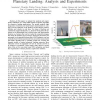Free Online Productivity Tools
i2Speak
i2Symbol
i2OCR
iTex2Img
iWeb2Print
iWeb2Shot
i2Type
iPdf2Split
iPdf2Merge
i2Bopomofo
i2Arabic
i2Style
i2Image
i2PDF
iLatex2Rtf
Sci2ools
RSS
2007
2007
Vision-Aided Inertial Navigation for Precise Planetary Landing: Analysis and Experiments
Abstract—In this paper, we present the analysis and experimental validation of a vision-aided inertial navigation algorithm for planetary landing applications. The system employs tight integration of inertial and visual feature measurements to compute accurate estimates of the lander’s terrain-relative position, attitude, and velocity in real time. Two types of features are considered: mapped landmarks, i.e., features whose global 3D positions can be determined from a surface map, and opportunistic features, i.e., features that can be tracked in consecutive images, but whose 3D positions are not known. Both types of features are processed in an extended Kalman filter (EKF) estimator and are optimally fused with measurements from an inertial measurement unit (IMU). Results from a sounding rocket test, covering the dynamic profile of typical planetary landing scenarios, show estimation errors of magnitude 0.16 m/s in velocity and 6.4 m in position at touchdown. These results vastly...
| Added | 30 Oct 2010 |
| Updated | 30 Oct 2010 |
| Type | Conference |
| Year | 2007 |
| Where | RSS |
| Authors | Anastasios I. Mourikis, Nikolas Trawny, Stergios I. Roumeliotis, Andrew Edie Johnson, Larry Matthies |
Comments (0)

